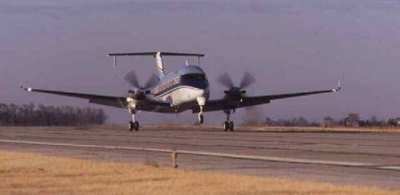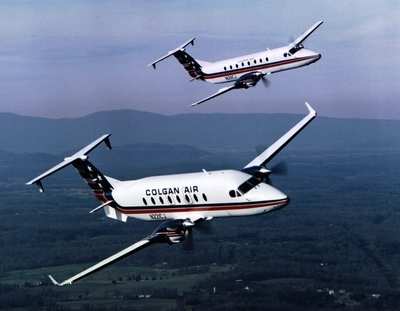Airlines Say Even With Gov't Help, They Just Can't Afford
It
With rising fuel costs and spiraling debt loads, one of the
first steps a number of regional airlines have taken to cut costs
has been to trim or cancel service to smaller communities, under
the Essential Air Services program.

EAS came about following the deregulation of the US commercial
airline industry in the late 1970s. Faced with backlash from
smaller towns that would suffer loss of airline service, once the
government could no longer force carriers to fly non-profitable
routes, the Department of Transportation came up with a subsidies
program to share costs. Airlines bid for EAS contracts offered by
DOT; for some small carriers like Air Midwest, EAS business made up
the bulk of their operations.
Regional carriers cite a number flaws with the program, but one
stands out above others in today's shaky economic climate: the
amount of subsidies on each route are fixed, and haven't increased
to compensate for skyrocketing fuel costs. As a result, many
carriers have attempted to renegotiate terms on EAS routes, with
varying levels of success.
So far this year, airlines have asked to opt out of EAS
contracts to 20 cities... almost matching the 2007 total of 24
communities. Often, those communities receive little warning
they're about to lose airline service.
According to the Associated Press, officials in Prescott, AZ
were surprised when Air Midwest sent them a one-page fax, stating
the struggling airline simply couldn't afford to fly its 19-seat
Beechcraft turboprops to their town anymore. That left some 129,000
people living near the northern Arizona community with only one
option: to drive two hours to catch a flight out of Phoenix.
"Everything was going fine -- then, bam -- the airline is gone,"
Mayor Jack Wilson said with a sigh. "That's just not how you do
business."
More and more towns can probably expect similar notices. The
government plans to slash the EAS budget for 2009 to $50 million...
less than half the program budget for each of the past seven years,
a sign the government is less-than optimistic about the program's
future, too.
 Jim Corridore, an
analyst with Standards & Poor's, says that's simply the cost of
doing business. "This is not a charity," Corridore said. "Airlines
are in a business to make money, and they're not. In fact, they're
losing billions of dollars. So something needs to be cut."
Jim Corridore, an
analyst with Standards & Poor's, says that's simply the cost of
doing business. "This is not a charity," Corridore said. "Airlines
are in a business to make money, and they're not. In fact, they're
losing billions of dollars. So something needs to be cut."
In the case of Air Midwest, that "something" proved to be the
entire airline. As ANN reported, the Mesa Air
Group subsidiary will go out of business by the end of this month,
leaving 20 cities in 10 states with fewer -- and in some cases,
zero -- options for air travel.
"It's been years since we turned a net profit," Air Midwest
President Greg Stephens explained. "We were trying to grow Air
Midwest through EAS," he added, but soon found customers were
opting to drive to large airports, rather than pay increased air
fares for commuter service. "The customer is more than willing to
hit the road. That's what we were competing with."
The Regional Airline Association is the trade group for commuter
and short-haul carriers. Group lobbyist Faye Malarkey said the
government could help save EAS, simply by increasing the amount of
funding it receives, to offset fuel costs.
Until that happens, airlines operating under EAS have but one
option to renegotiate terms: ask DOT to release them from their EAS
obligations, and then wait 180 days to rebid for the contract... if
DOT allows them to do so. The only other option for carriers is to
simply halt service outright, and deal with the resulting legal
actions from DOT, and the slighted towns.
"It really is just about the worst thing you can do to the
service," Markeley said. "You've got the community up in arms. They
don't quite understand. The airline seems to be abandoning
them."

For its part, the DOT admits EAS needs to be overhauled... but
the agency does not support increased subsidies to offset fuel
costs, to cities it says could do without commuter air service.
Instead, the agency is refocusing its efforts, offering subsidies
only on routes to the most isolated communities.
"EAS reform is needed to ensure the program serves the people it
was designed to serve -- those who have no other viable travel
options," DOT spokesman Bill Mosely told the AP.
That explanation doesn't fly with folks like W. Gary Edwards,
town supervisor for Massena, NY near the US-Canada border. "It's a
necessity, not a luxury," said Edwards. "We're all the way at the
top of New York state. We don't have a four-lane highway. All our
roads up here are country roads."
Then again, Massena -- for now, anyway -- is one of the lucky
ones. The town lost air service last November, when Big Sky
Airlines discontinued service... but another airline, Capital Air
Services, is expected to start operations in September.
 NTSB Prelim: Piper PA-23
NTSB Prelim: Piper PA-23 Classic Aero-TV: One Mans Vietnam
Classic Aero-TV: One Mans Vietnam NTSB Final Report: Capella Aircraft Corp FW1C50
NTSB Final Report: Capella Aircraft Corp FW1C50 Classic Aero-TV: Timber Tiger Touts Curtiss Jenny Replicas
Classic Aero-TV: Timber Tiger Touts Curtiss Jenny Replicas ANN's Daily Aero-Term (07.04.25): Performance-Based Navigation (PBN) [ICAO]
ANN's Daily Aero-Term (07.04.25): Performance-Based Navigation (PBN) [ICAO]





